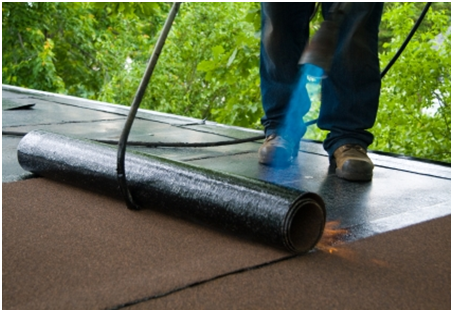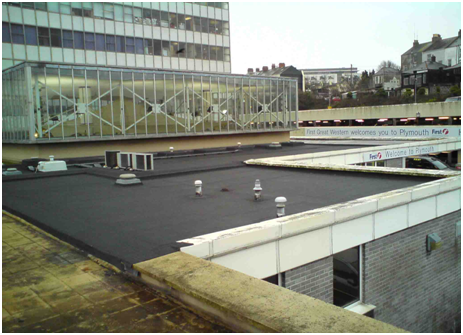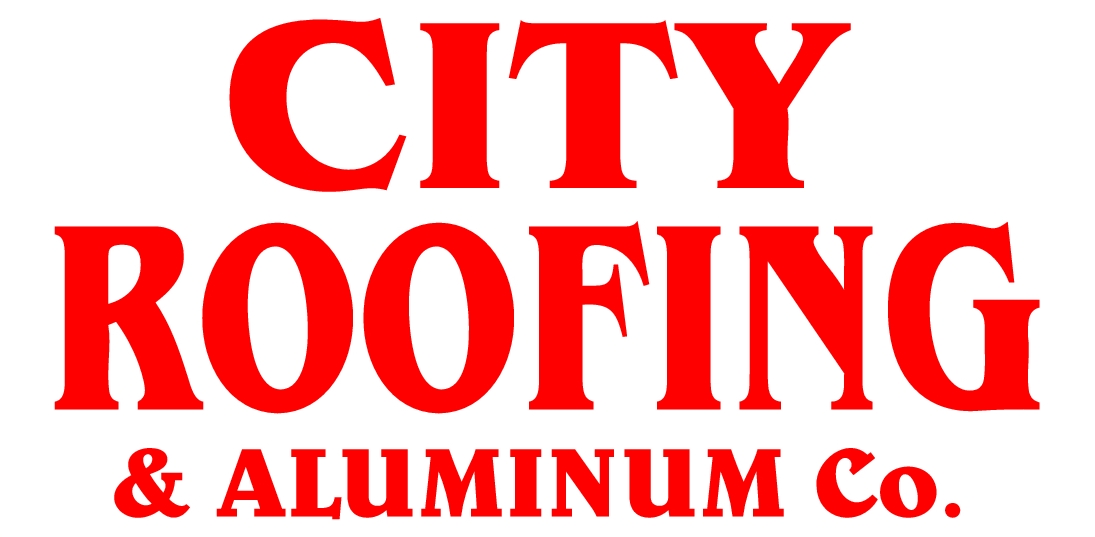Flat Roof System (FAQ)
What are the major FLAT roofing systems?
The two broad categories of asphalt roofing systems for commercial,
industrial and institutional buildings are
Built-Up Roofing (BUR)
and
Modified Bitumen Systems (MBS).
What is Built-Up Roofing (BUR)?
Built-up Roofing (BUR)
is the most popular choice of roofing used on commercial, industrial
and institutional buildings. BUR is used on flat or low-sloped roofs
and consists of multiple layers of bitumen and ply sheets.
Components of a BUR system include the roof deck, a vapor retarder,
insulation, membrane and surfacing material. The components are
assembled at the job site to actually form the built-up roof. At the
heart of this roofing system is the roofing membrane, which consists
of roofing bitumen and multiple reinforcing plies of roofing felt.
Roofing bitumen is the primary adhesion/waterproofing agent used
between roofing plies. Bitumen arrives at the job site in solid
form, but is heated and applied as a liquid. Roofing bitumens may be
either a product of petroleum refining (asphalts) or a product of
the coal-cooking process (coal tar pitch).
Multiple reinforcing “plies”
are asphalt-coated roofing sheets or felts installed in three or
more layers to strengthen and stabilize the BUR membrane. These
multiple reinforcing felts also make the membrane more pliable and
resilient, protect the bitumen from water degradation, and serve as
a fire-retarding element in the membrane system.
BUR roofing membranes can be protected from solar radiation by
embedding gravel in the bitumen, applying a surface coating or
applying a granular-surfaced “cap” sheet. Light-colored surfacing
materials can be used to reflect heat from the building. In
addition, surfacing agents can provide additional fire protection.
How is BUR applied for maximum performance?
It’s critical to get secure bonding of the roofing felts (plies)
using bitumen. To achieve this bond the roofing contractor applies
thin, uniform moppings of bitumen. This waterproofs the system and
ensures proper adhesion for fusing the membrane system together. The
temperature of the bitumen is critical. By heating it to the proper
temperature the roofing contractor gets the right viscosity for
proper mopping. The contractor heats the bitumen to its EVT or
Equiviscous Temperature, the temperature at which it can be most
effectively mopped into uniform layers. Each batch of bitumen should
be labeled by the supplier with its EVT. Once felts are
rolled into place on the heated bitumen applicators pull brooms or
squeegees over the felt or use some other method to make sure that
its embedded in the bitumen. The strength of the membrane depends on
the type of felt used, the number of plies, overall ply
construction, and the lapping of the overlaying felts. Typically,
membrane ply construction is defined by headlap, endlap,
and sidelap.
Headlap
is the distance of the overlap that exists between the lowermost and
the uppermost plies of the shingled portion of the roof membrane
when measured perpendicular to the long dimension of the membrane.
Endlap
is the overlap distance that is measured from where one roll of
felt ends to where another begins.
Sidelap
is the overlap distance along the length of the felt where one
roll of felt overlaps the adjacent overlying felt.
The application of Built-Up Roofing systems is detailed work, but
the professional who pays particular attention to those details such
as curbs, walls, flashings or other projections that interrupt the
membrane, achieves a quality, efficient, long-lasting product for
the building owner.
What are some of the advantages of BUR?
Built-up roofing systems (BUR) have had a long-standing popularity,
due in large part to the success and proven reliability of BUR. The
stock of 20, 30 and 40-year-old BUR roofs still in excellent
condition attests to this fact.
Specifically, BUR roofs offer:
Multi-Layer Protection
– the multiple layers of bitumen and bitumen saturated “felts” make
a watertight barrier capable of providing many years of reliable
protection from the elements.
Thermal Performance
– Built-up roofing systems exhibit exceptional resistance to the
conduction of heat between the exterior and interior of a building,
resulting in noticeable reductions in heating and cooling costs.
Fire and Uplift Resistance
- Built-up roofing systems are tested through Factory Mutual
Research Corporation to meet very strict fire resistance
requirements and ensure adequate uplift resistance under extreme
wind conditions.
Economy
- Compared to other high performance commercial roofing systems,
built-up roofing is one of the best investments on the market due to
its competitive cost per year of expected service life.
What is Modified Bitumen (MB) or Modified Bitumen Membranes (MBS)?
Modified bitumen membranes (MBS)
combine the features of a built-up roof with the added tensile
strength from its polymer modification. Using a reinforced sheet
that is prefabricated in the plant, modified bitumen systems require
a less labor-intensive application and can be applied cross-platform
in both commercial and certain residential applications.
A modified bitumen roofing system is composed primarily of
polymer-modified bitumen reinforced with one or more plies of fabric
such as polyester, fiberglass or a combination of both. Factory
surfacing, if applied, includes mineral granules, slag, aluminum or
copper. The bitumen determines the membrane’s physical
characteristics and provides primary waterproofing protection; while
the reinforcement adds strength, puncture resistance and overall
system integrity.
Factory-assembled, modified bitumen membranes undergo strict quality
control standards to ensure uniform thickness and consistent
physical properties throughout the membrane. The finished roofing
system is usually a two- to four-ply system consisting of a modified
bitumen membrane and a base sheet, with additional plies for added
strength if needed. The substrate often determines which ply system
is best specified.
The finished roofing membrane may consist of one or more modified
bitumen sheets, or it may be comprised of a combination of built-up
roofing (BUR) felts and one or more modified bitumen sheets. The
type of substrate and the performance objectives influence the
specification of the modified bitumen membrane system.
There are modified bitumen membranes tailored to almost every type
of construction design and climate: for new roofing or re-roofing of
commercial buildings, residential high rises, domes, spires, and
most categories of low-slope or steep-roof roofing. Thus there are a
variety of modifiers, and types of reinforcements and surfacings
available.
What are Modified Bitumen modifiers? How do they work?
Modified bitumens generally use a traditional waterproofing medium —
asphalt — modified with atactic polypropylene (APP), styrene
butadiene styrene (SBS), synthetic rubber or other agents that
create a uniform matrix that enhances the physical properties of the
asphalt. SBS and APP are the most common bitumen modifiers.
SBS (Styrene-Butadiene-Styrene)
modifies the asphalt by forming a polymer network within the
bitumen. SBS gives the bitumen rubber-like characteristics and
improved resistance to aging and weathering. Most SBS-modified
bitumen sheets are either set in hot mopping asphalt, torch-applied
or adhered with cold-process adhesives. SBS-modified bitumen sheets
that do not have factory applied granule or foil surfacing need some
form of field-applied ultraviolet protective coating.
APP (Atactic Polypropylene)
is a thermoplastic polymer, which forms a uniform matrix within
the asphalt. This enhances the bitumen’s performance by increasing
its UV resistance, increasing its flexibility at low temperatures
and improving its flow resistance at high temperatures. APP-modified
bitumen sheets are generally applied using a propane-fueled torch.
Applicators use the heat to soften the modified bitumen on the
underside of the sheet. The sheet’s bottom surface becomes a molten
adhesive, which flows upon the substrate and then cools to form a
waterproof adhesive bond. Some APP sheets can also be applied with
cold process adhesives.
What are reinforcing plies? What are they made of?
While modified asphalt provides the primary waterproofing
characteristics of these membranes a reinforcing ply adds strength
and puncture resistance. Glass fiber and polyester plies are the
most commonly used reinforcing fabrics. Each has distinctive
properties. Polyester has excellent elongation, tensile strength and
recovery. It provides good puncture resistance and stands up well to
foot traffic. Glass fiber resists flame penetration and provides
excellent tensile strength and dimensional stability.
How do I choose the roofing system that works best for a particular
job?
The combination of asphalt, modifiers and reinforcements
determines the characteristics of a specific modified bitumen
membrane. To obtain the best roofing system possible, the designer,
building owner and contractor should understand the dynamics of the
roof as well as the roofing system when specifying either APP or SBS
modified roofs.
The architect, specifier, building owner, and roofing contractor
should examine the following parameters when choosing a roofing
system:
-
What is the building’s type and usage?
-
What building code requirements apply to the system?
-
What is the estimated service life of the roof system?
-
What kind of roof deck will be used (type, size, slope)?
-
How much is the roof deck expected to move relative to the roof
perimeter?
-
Shrinkage of the deck material?
-
Moisture content of the deck?
-
Access for equipment on the roof?
How is Modified Bitumen roofing applied for maximum performance?
The application of modified bituminous roofing is a construction
process that involves the skillful arrangement of several components
as specified for the process. Roof performance is determined by
factors that include building design, job specifications, materials
quality and suitability, application procedures and maintenance. The
level of quality in the workmanship during the application process
is critical.
The application of modified bitumen roof systems is not an exact
science. It’s a craft that involves people, roofing professionals,
who deal with a broad range of materials, designs, customs,
techniques, weather events, and climates.
Why choose Modified Bitumen roofing systems?
Click here to see the Asphalt Roofing vs. Competition Chart
Since gaining acceptance in the roofing industry during the 1970s,
the use of modified bitumen membrane roofing systems has increased
steadily. Today modified bitumen membranes are the fastest growing
roofing materials in the industry. Considered a quality “hybrid”
system, MBS provides the features of a built-up roof with the added
tensile strength and elongation of a modified bitumen cap sheet, as
well as the quality assurance of in plant membrane fabrication
uniformity and control, and reduced labor requirements for
installation. In addition, MBS products undergo the same fire and
uplift resistance testing standards as BUR, providing the commercial
customer full assurance of appropriate fire and uplift resistance.











